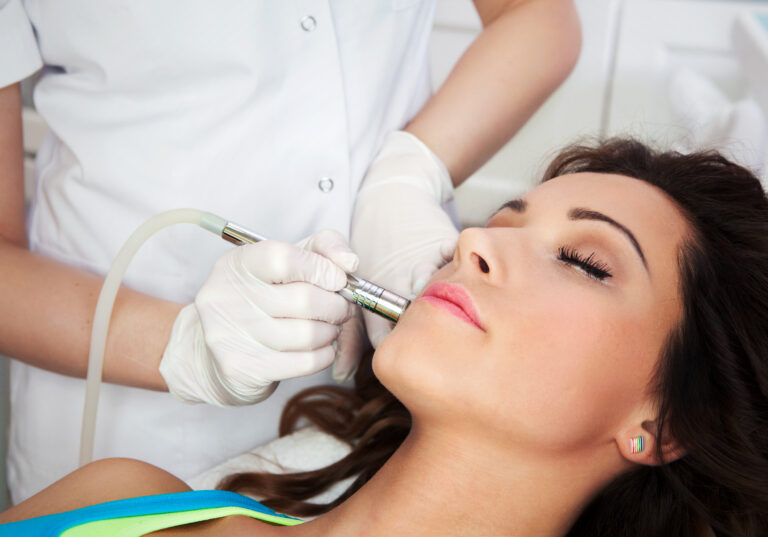Exciting new cosmetic procedures like laser facial resurfacing can make you look years younger. It’s an alternative to face-lifts or Botox and can tighten your skin, remove lesions, and even out your skin tone for a consistent, more youthful look. So how does skin resurfacing work?
What Is Laser Facial Resurfacing?
Laser resurfacing uses a concentrated laser light pulse to remove layers of skin or heat underlying skin tissue. An ablative laser will remove the epidermis (the outer layer of skin) by heating the water in your skin, which causes skin cells to evaporate. A nonablative laser treatment will heat the dermis (the underlying layer) without removing the top layer. It may take several treatments to achieve results.1
Laser facial resurfacing can eliminate discoloration or blemishes AND stimulate the growth of new collagen fibers. The procedure is relatively quick, taking between 30 minutes and two hours, depending on the size and scale of the areas being treated. It can be painful, so anesthetics or sedatives may be used. Doctors may also recommend patients undergo skin treatments up to six weeks in advance to help reduce the risk of complications during treatment.2
After treatments, patients need to avoid sun exposure for a few months and may need to use sunscreen to prevent pigment changes. Dressing, ice packs, and cool compresses may limit swelling during recovery. It is not unusual for patients to have sore, itchy, or swollen skin for a few days after treatment and undergo some peeling after a week or so.3
What Are the Benefits of Laser Facial Resurfacing?
As the skin begins to regrow, it may look fuller, and wrinkles and age spots will be less noticeable. Most patients see skin that is smoother, softer, and firmer.
If laser skin resurfacing is used to treat scarring, the results are permanent.4 After treatments for other skin conditions, the skin’s surface may continue to improve for up to a year. However, it does not reverse aging. While laser skin resurfacing can make you look younger for years, signs of aging will show. However, you can repeat treatments to maintain results.
What Are the Types of Facial Laser Resurfacing?
Depending on your condition, there are different types of facial laser resurfacing that may be recommended, including:
- Carbon dioxide (CO2) lasers
- Erbium lasers
- Fractional lasers
- Pulse-dye lasers
Ablative lasers are more invasive, as they remove the outer layer of skin. Nonablative lasers will evaporate skin cells without damaging the epidermis.
CO2 laser resurfacing
The newest generation of carbon dioxide lasers utilizes short pulses of light energy or light beams using a scanning pattern to remove layers of skin.5 Ablative therapy using a CO2 laser allows precise patterns to remove top layers with minimal damage from the heat.
Recovery time can take up to two to three weeks, and there can be side effects, such as swelling, redness, and bruising. CO2 laser resurfacing is successfully used to treat wrinkles, scars, warts, birthmarks, and other skin conditions.
Erbium laser resurfacing
An erbium laser resurfacing treatment is nonablative. Treatments are used to remove light to moderately deep lines and wrinkles.6 Erbium laser treatments generally produce fewer side effects and typically result in shorter recovery times.
It’s also a good choice for those with darker skin tones.
Fractional laser resurfacing
Fractional laser resurfacing also uses a CO2 laser but delivers narrow columns of laser light to specific areas of your skin. This creates tiny holes in your skin, allowing the skin underneath to tighten as collagen contracts.7 This treatment penetrates more deeply, so there is a slightly greater risk of scarring. Still, recovery time is usually about a week.
Fractional lasers can be either ablative or nonablative.
Pulse-dye lasers
Pulse-dye lasers, also referred to as vascular lasers, treat blood vessels that result in skin issues. Lasers are generally nonablative, using a concentrated yellow light beam to heat the skin and absorb pigments. Pulse-dye lasers can treat rosacea, broken capillaries, redness, and hyperpigmentation.
Who Benefits From Laser Facial Resurfacing?
You may be a good candidate for laser facial resurfacing if you have wrinkles, worry lines, or folds. It is also an effective treatment for people with:8
- Uneven skin pigmentation
- Scars and birthmarks
- Acne or chickenpox scars
- Sun-damaged skin
- Fine lines around eyes, mouth, or forehead
- Enlarged glands
- Age spots
- Liver sports
Patients who did not respond well to a face-lift may also benefit from laser facial resurfacing. However, people with active acne, deep wrinkles, baggy or sagging skin, or very dark skin are likely not good candidates.9
How Much Does Laser Facial Resurfacing Cost?
According to the American Society of Plastic Surgeons, treatments can cost between $1,500 and $2,500.10 This does not include other expenses that may also be necessary. For example, there may be fees for anesthesia (if required), surgical facilities, and prescription costs.
Prices may also depend on location, the type of procedure used, how long the treatment takes, and the experience of the specialist performing the procedure.
How Do You Choose the Right Specialist for Laser Facial Resurfacing?
You should discuss your options with your doctor or an experienced laser facial resurfacing specialist to see if laser facial resurfacing is right for you.
Different states have different laws, so many places and professionals can offer laser facial resurfacing. However, you will get the best results from a board-certified plastic surgeon or dermatologist with extensive experience providing laser treatments.11 Visit My Skin Treatment today for more in-depth articles on laser treatments and more.
SOURCES:
- Cleveland Clinic: Laser Skin Resurfacing
- Medical News Today: How does laser skin resurfacing work?
- Medical News Today: How does laser skin resurfacing work?
- Everyday Health: What to Know Before Undergoing Laser Resurfacing for Better Skin
- Cleveland Clinic: Carbon Dioxide Laser Resurfacing
- Cleveland Clinic: Laser Skin Resurfacing
- Cleveland Clinic: Laser Skin Resurfacing
- Cleveland Clinic: Laser Skin Resurfacing
- Cleveland Clinic: Laser Skin Resurfacing
- American Society of Plastic Surgeons: Laser Skin Resurfacing
- American Society of Plastic Surgeons: Laser Skin Resurfacing






